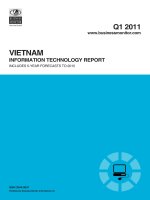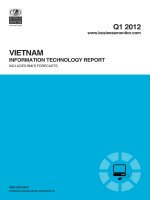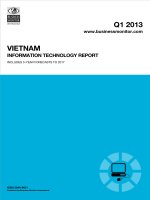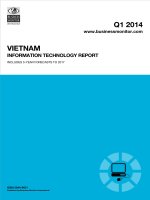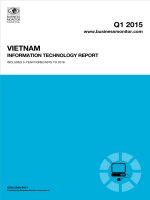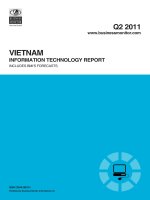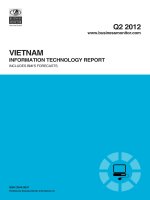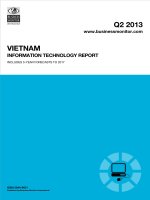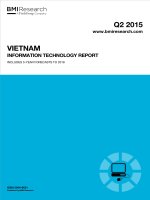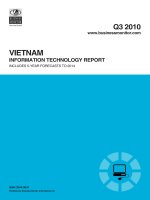Vietnam information technology report q3 2015
Bạn đang xem bản rút gọn của tài liệu. Xem và tải ngay bản đầy đủ của tài liệu tại đây (446.18 KB, 93 trang )
Q3 2015
www.bmiresearch.com
VIETNAM
INFORMATION TECHNOLOGY REPORT
INCLUDES 5-YEAR FORECASTS TO 2019
ISSN 2044-9631
Published by:BMI Research
Vietnam Information Technology Report
Q3 2015
INCLUDES 5-YEAR FORECASTS TO 2019
Part of BMI’s Industry Report & Forecasts Series
Published by: BMI Research
Copy deadline: June 2015
BMI Research
Senator House
85 Queen Victoria Street
London
EC4V 4AB
United Kingdom
Tel: +44 (0) 20 7248 0468
Fax: +44 (0) 20 7248 0467
Email:
Web:
© 2015 Business Monitor International Ltd
All rights reserved.
All information contained in this publication is
copyrighted in the name of Business Monitor
International Ltd, and as such no part of this
publication may be reproduced, repackaged,
redistributed, resold in whole or in any part, or used
in any form or by any means graphic, electronic or
mechanical, including photocopying, recording,
taping, or by information storage or retrieval, or by
any other means, without the express written consent
of the publisher.
DISCLAIMER
All information contained in this publication has been researched and compiled from sources believed to be accurate and reliable at the time of
publishing. However, in view of the natural scope for human and/or mechanical error, either at source or during production, Business Monitor
International Ltd accepts no liability whatsoever for any loss or damage resulting from errors, inaccuracies or omissions affecting any part of the
publication. All information is provided without warranty, and Business Monitor International Ltd makes no representation of warranty of any kind
as to the accuracy or completeness of any information hereto contained.
CONTENTS
BMI Industry View 7
SWOT 9
IT SWOT 9
Political 11
Economic 12
Operational Risk 14
Industry Forecast 16
Table: IT Industry - Historical Data And Forecasts (Vietnam 2012-2019) 16
Macroeconomic Forecasts 24
Economic Analysis 24
Table: Economic Activity (Vietnam 2010-2019) 29
Industry Risk Reward Index 30
Table: Asia Pacific IT Risk/Reward Index - Q315 32
Market Overview 33
Hardware 33
Software 40
Cloud Computing 47
Services 51
Industry Trends And Developments 58
Regulatory Development 63
Table: Government Authority 63
Regulatory News 66
Competitive Landscape 69
International Companies 69
Table: Samsung Electronics 69
Table: Intel 70
Table: LG Electronics 71
Table: Global CyberSoft 72
Local Companies 73
Table: Sara Vietnam 73
Company Profile 74
FPT Software 74
Table: FPT Group Financials By Segment (VNDbn) 78
Regional Overview 80
Vietnam Information Technology Report Q3 2015
© Business Monitor International Ltd Page 4
Demographic Forecast 83
Table: Population Headline Indicators (Vietnam 1990-2025) 84
Table: Key Population Ratios (Vietnam 1990-2025) 84
Table: Urban/Rural Population & Life Expectancy (Vietnam 1990-2025) 85
Table: Population By Age Group (Vietnam 1990-2025) 85
Table: Population By Age Group % (Vietnam 1990-2025) 86
Methodology 88
Industry Forecast Methodology 88
Sources 89
Risk/Reward Index Methodology 90
Table: It Risk/Reward Index Indicators 91
Table: Weighting Of Components 92
Vietnam Information Technology Report Q3 2015
© Business Monitor International Ltd Page 5
BMI Industry View
BMI View: The key component for our forecast for Vietnamese IT market growth outperformance over the
medium term is our view that broad based economic growth will substantially deepen the retail hardware
market. This view is supported by the introduction of a household growth forecast for Vietnam in the
forecast section of the Q315 update. We forecast a compound annual growth rate (CAGR) of 11.6%
2015-2019, with total spending expected to increase from 1.52% of GDP in 2014 to 1.57% in 2019.
Meanwhile, Vietnam's development as an outsourcing destination is a significant medium-term factor, with
the services segment expected to expand rapidly. There is also increasing momentum towards Vietnam
becoming a global centre for electronics production as wages rise in China and manufacturers look to
protect margins by moving to Vietnam, where wages are as little as a third of those in China.
Headline Expenditure Projections:
■
Computer Hardware Sales: VND37.0trn in 2014 and VND40.8trn in 2015, rising to VND57.5trn in
2019, CAGR of +10.1% in local currency terms. Forecast upgraded in Q315 after strong sales reported by
local retailers in H115 for the Tet New Year holiday season.
■
Software Sales: VND9.0trn in 2014 and VND9.9trn in 2015, rising to VND16.1trn in 2019, CAGR of
+12.4% in local currency terms. The enterprise software market as a whole set for strong growth, with
security solutions a particularly strong sub-segment for vendors willing to accept narrow margins in a
price-sensitive market.
■
IT Services Sales: VND13.7trn in 2014 and VND16.0trn in 2015, rising to VND29.8trn in 2019, CAGR
of +16.8% in local currency terms. IT services forecast to outperform 2015-2019 as increased domestic
demand for cloud computing and outsourcing services expected to drive strong growth.
Key Trends And Developments: In addition to our positive outlook for IT market growth, BMI also has a
bullish outlook for the development of Vietnam's IT industry - particularly electronics manufacturing and
outsourcing provision. A key factor helping to attract significant inward investment to electronics
manufacturing is the government's Hi-Tech Parks policy. In June 2015, the plan was extended - with new
parks set to be constructed between 2015 and 2030 through a combination of central government direction,
local government funds and private capital. In addition to creating new parks, it also plans to further
develop existing facilities including Hoa Lac Hi-Tech Park in Hanoi City, Saigon Hi-Tech Park in Ho Chi
Minh City and Danang Hi-Tech Park. The expansion is based on recent success in Vietnam's development
goal of promoting high tech manufacturing as a source of higher productivity employment, as well as
benefiting Vietnam through technological transfer.
Meanwhile, the Vietnamese outsourcing industry was boosted in July 2014 when the prime minister of
Vietnam enabled state agencies to use outsourced information technology providers for the first time, a
Vietnam Information Technology Report Q3 2015
© Business Monitor International Ltd Page 7
ruling that came into effect in February 2015. It enables IT firms to provide software and technology
systems as service packages to the public sector. FPT Information Systems CEO Do Cao Bao stated that the
main IT services in Vietnam are system management, cloud software leasing and maintenance services as
the largest component at around VND4-5trn a year. It is these areas that are expected to generate the most
demand in the public sector, which BMI believes represents a significant new area of growth for vendors.
However, confidence remains a major impediment to adoption. Managers are unsure of the benefits of IT
outsourcing, as well as having concerns about security and a loss of control over key processes. A report
from Grant Thornton International stated that only 12% of enterprises in Vietnam are open to outsourcing.
BMI expects outsourcing adoption to accelerate once awareness of the benefits is more widely spread, and
vendors ease manager concerns.
Vietnam Information Technology Report Q3 2015
© Business Monitor International Ltd Page 8
SWOT
IT SWOT
SWOT Analysis
Strengths
■
Supportive policy framework and funding in place to promote the development of the
IT sector.
■
Vietnam's gradual integration into the global trade network via its accession into trade
organisations such as the Association of Southeast Asian Nations (ASEAN) and WTO,
as well as bilateral agreements with Japan and China.
■
The domestic IT market is in a rapid growth phase, with trade liberalisation and
growing affordability driving increased adoption among enterprises and consumers.
■
Expanding local hardware production industry with major international players such
as Samsung, Nokia, LG and Intel making large investments.
■
Vietnam is a preeminent global outsourcing destination, with a particular strength in
the software development industry.
Weaknesses
■
IT spend per capita is much lower than in neighbouring Thailand, reflecting a much
lower GDP per capita.
■
Highly price-sensitive market, putting pressure on vendor margins.
■
High level of software piracy, with a stall in the reduction 2011 to 2013.
■
Cybersecurity measures by the government have been pushed through with state
security measures, with potential human rights implications.
Opportunities
■
Broad based economic growth forecast to drive retail hardware market growth as
household incomes increase markedly 2015-2019.
■
Decision in July 2014 to enable state agencies to use outsourced information
technology providers for the first time opens a new growth channel for vendors.
Vietnam Information Technology Report Q3 2015
© Business Monitor International Ltd Page 9
SWOT Analysis - Continued
■
Low PC penetration means there is scope for vendors to tap first-time buyer market
as well as the upgrade/replacement market. Due to low penetration desktop and
notebook sales continue to increase despite competition from tablets.
■
Low-cost tablets are proving popular with consumers, with significant medium-term
sales growth potential as incomes continue to rise.
■
Vietnam is a popular destination for software development and IT services
outsourcing, with particularly strong growth potential from Japanese enterprises that
are turning away from Chinese based providers.
■
National IT Plan will drive sector development, as well as public spending on IT
utilisation in areas such as e-government, e-taxation and education.
■
Small- and medium-sized enterprises have much potential to increase spending on
basic solutions, including customer relationship management and security.
■
The government's drive to create an IT services industry over the next 15-20 years -
including the NATIF fund - is expected to be accelerate the development of local
enterprises.
■
Cloud computing awareness has risen fast and adoption is expected to accelerate
through 2014 and 2015, with virtualisation expected to be a significant growth trend in
the short-to-medium term.
Threats
■
Low-cost tablets from own-brand Chinese vendors a particular threat to low- and
mid-range notebook vendors. Falling prices may further undermine margins and
profitability after steep discounting.
■
Cybersecurity issues could undermine confidence in IT solutions and services, with
big data and cloud computing vulnerable.
■
Yen depreciation has hit the software outsourcing market by making exports less
competitive and eroding Vietnam's cost advantages.
Vietnam Information Technology Report Q3 2015
© Business Monitor International Ltd Page 10
Political
SWOT Analysis
Strengths
■
The Communist Party of Vietnam remains committed to market-oriented reforms and
we do not expect major shifts in policy direction over the coming years. The one-party
system is generally conducive to short-term political stability.
■
Relations with the US have witnessed a marked improvement, and Washington sees
Hanoi as a potential geopolitical ally in South East Asia.
Weaknesses
■
Corruption among government officials poses a major threat to the legitimacy of the
ruling Communist Party.
■
There is increasing (albeit still limited) public dissatisfaction with the leadership's tight
control over political dissent.
Opportunities
■
The government recognises the threat corruption poses to its legitimacy, and has
acted to clamp down on graft among party officials.
■
Vietnam has allowed legislators to become more vocal in criticising government
policies. This is opening up opportunities for more checks and balances within the
one-party system.
Threats
■
Although strong domestic control will ensure little change to Vietnam's political scene
in the next few years, over the longer term, the one-party-state will probably be
unsustainable.
■
Relations with China have deteriorated over recent years due to Beijing's more
assertive stance over disputed islands in the South China Sea.
Vietnam Information Technology Report Q3 2015
© Business Monitor International Ltd Page 11
Economic
SWOT Analysis
Strengths
■
Vietnam has been one of the fastest-growing economies in Asia in recent years, with
GDP growth averaging 6.5% annually between 2000 and 2014.
■
The economic boom has lifted many Vietnamese out of poverty, with the official
poverty rate in the country falling from 58% in 1993 to 17.2% in 2012.
■
Vietnam has been strengthening its trade and aid ties in a bid to increase exports and
diversify its export sector.
Weaknesses
■
Vietnam still suffers from fiscal deficits, leaving the economy vulnerable to global
economic uncertainties. The fiscal deficit is dominated by substantial spending on
social subsidies that could be difficult to withdraw.
■
The heavily-managed and weak currency reduces incentives to improve quality of
exports, and also keeps import costs high.
Opportunities
■
WTO membership and the ASEAN economic integration in 2015 should give Vietnam
greater access to both foreign markets and capital, while making Vietnamese
enterprises stronger through increased foreign competition.
■
The government has continued to move forward with market reforms, including
privatisation of state-owned enterprises, addressing the high level of bad loans in the
banking sector as well as liberalising the banking sector.
■
Urbanisation will continue to be a long-term growth driver. The UN forecasts the
urban population rising from 32% of the population in 2013 to more than 50% by the
early 2040s.
Threats
■
Although inflation has subsided in 2014, complacency by the State Bank of Vietnam
on this front could result in a decline in investment.
■
The potential for an escalation of political tensions with China over sovereign claims
to parts of the South China Sea could have a negative impact on the economy.
Vietnam Information Technology Report Q3 2015
© Business Monitor International Ltd Page 12
SWOT Analysis - Continued
■
Market reforms could progress at a much slower pace as the government remains
cautious about ceding ownership to foreign investors.
Vietnam Information Technology Report Q3 2015
© Business Monitor International Ltd Page 13
Operational Risk
SWOT Analysis
Strengths
■
Vietnam has a high number of university graduates with skilled degrees and a high
literacy rate for its income level.
• In addition to a number of regional and international flight options, Vietnam has an
extensive inland waterway system.
• Growing levels of foreign investment encourage further trade and spin-off industries.
• Vietnam's rate of violent crime is generally low, and foreigners are unlikely to be
targeted.
Weaknesses
■
High labour costs increase overall operating costs, and difficulty in hiring foreigners
creates shortages of skilled labour.
• Underdeveloped rail capacity overburdens the road network.
• An underdeveloped banking sector decreases the options for keeping money in the
state.
• Vietnam's military forces are only a quarter the size of China's, meaning that Beijing
would probably prevail in any naval battle over maritime disputes in the South China
Sea.
Opportunities
■
Explosive growth in demand for tertiary education will increase the number of highly
skilled graduates in the medium term.
• Vietnam is easily accessible from the main shipping routes, and growth in the number
of port facilities will provide adequate capacity.
• Increased foreign participation in the banking sector will increase the availability of
funds for loans.
Threats
■
Dysfunctional labour-management relations increase the risk of disruption and strike
action.
Vietnam Information Technology Report Q3 2015
© Business Monitor International Ltd Page 14
SWOT Analysis - Continued
• Vietnam's reliance on imported oil poses risks in the form of energy and fuel
shortages.
• Corruption and inefficiency in the legal system.
• Anti-Chinese violence, as seen in May 2014, could be a harbinger of wider political
and social unrest.
Vietnam Information Technology Report Q3 2015
© Business Monitor International Ltd Page 15
Industry Forecast
Table: IT Industry - Historical Data And Forecasts (Vietnam 2012-2019)
2012 2013 2014e 2015f 2016f 2017f 2018f 2019f
IT market
value,
VNDmn
46,064,455 54,190,225 59,717,628 66,585,156 73,822,962 82,342,132 92,396,106 103,372,764
Computer
hardware
sales,
VNDmn
29,250,929 34,139,842 37,024,930 40,750,115 44,146,131 48,087,805 52,665,781 57,475,257
Personal
computer
sales,
VNDmn
23,544,073 27,479,159 29,793,961 32,783,468 35,502,319 38,681,830 42,385,420 46,279,077
Software
sales,
VNDmn
6,550,366 7,705,850 8,969,588 9,854,603 11,073,444 12,516,004 14,229,000 16,126,151
Services
sales,
VNDmn
10,263,161 12,344,533 13,723,111 15,980,437 18,603,386 21,738,323 25,501,325 29,771,356
IT market
value, %
of GDP
1.4 1.5 1.5 1.6 1.6 1.6 1.6 1.6
e/f = BMI estimate/forecast. Source: BMI
BMI upgraded the forecast for IT spending in Vietnam in 2015 in the Q315 update after local retailers
reported very strong sales in the retail market in H115, particularly in the Tet New Year holiday season.
This is strengthened by our long-held view that the Vietnamese IT market holds the potential for medium-
term outperformance, in the Asia Pacific region and globally. We derive our bullish outlook from the
supportive government policy environment, our in-house Country Risk team's view for robust and broad
based income growth, declining device prices at the global and regional level, enterprise modernisation and
the shift towards higher productivity activities such as manufacturing and outsourcing, Vietnam's large and
growing population, and finally investments in telecoms and retail infrastructure.
The IT market in Vietnam is relatively undeveloped compared to most Asia Pacific markets, but as it
outperforms with rapid 'catch-up' growth the IT sector will account for a growing share of GDP over the
duration of our five-year forecast to 2019. We also highlight the development of Vietnam's local IT
industry, with software development and outsourcing services firms developing rapidly and positioned to
benefit from large foreign enterprises seeking lower cost locations over the medium-term. BMI forecasts
Vietnam Information Technology Report Q3 2015
© Business Monitor International Ltd Page 16
the IT market in Vietnam will expand at a compound annual growth rate (CAGR) of 11.6% forecast for
2015-2019 and the market expected to reach a value of almost VND103.4trn in 2019.
IT Market Growth
(2012-2019)
Vietnam - IT market value, VNDmn
2012 2013 2014e 2015f 2016f 2017f 2018f 2019f
0
25,000,000
50,000,000
75,000,000
100,000,000
125,000,000
e/f = BMI estimate/forecast. Source: BMI
2015 Outlook: After a tightening of credit conditions in Vietnam in H214 saw retail spending slow, retail
hardware spending in 2015 accelerated in a stronger economic climate, with an added boost from deferred
purchases in 2014. While our core scenario is for robust growth in IT market spending in 2015, there is
downside risk for further credit tightening, a traditional drag on market development in Vietnam, though
one which had become a less significant factor as a result of partnerships between banks and retailers
formed in 2013. Further tightening is not however our core scenario, with the wider Vietnamese economy
still on track to record strong growth. We forecast real GDP growth of 6.4% in 2015 and real growth of
private final consumption of 6.5%, growth rates that will support a buoyant retail hardware market given the
relatively broad based complexion of economic growth in Vietnam.
We forecast the PC market trend from 2014 will continue into 2015, with growth forecast for desktop,
notebook and tablet shipments as rising incomes and declining device prices promote first-time buyer and
Vietnam Information Technology Report Q3 2015
© Business Monitor International Ltd Page 17
upgrade sales. Reports from retailers in H115 indicate sales grew even faster than our forecast in the Q215
update, resulting in a hardware spending growth forecast upgrade to 10.1% in 2015 in local currency terms.
Tablets will again see strong growth, extending the trend dating back to the influx of low-priced Chinese
own-brand tablets in 2012 that deepened the market. Meanwhile, notebook sales are recovering after the
initial impact of the tablet boom, aided by lower prices. There was also evidence in 2014 that hybrid
notebooks carved out a niche and by H214 were beginning to challenge tablets by offering multi-use cases,
a potentially significant trend in emerging markets where consumers are focused on value for money more
than the fashion cache of tablets. However, hybrid notebook prices remain sufficiently elevated to preclude
mass market appeal in 2015 in Vietnam, where incomes are still heavily weighted towards the low end.
Government demand is becoming a more important source of sales to IT market vendors, and BMI expects
an extension of this trend in 2015. The Ministry of Information and Communication's released a proposal in
August 2013 to allocate at least 2% of the state budget to boosting the IT sector each year. The government
is actively promoting IT market development in several areas including PC subsidy programmes, licensing
software used by government agencies and enabling state agencies to use outsourced information
technology providers for the first time in 2014.
Another important role of the government is in promoting the development of local IT industry in Vietnam.
An important component is the government's Hi-Tech Park policy, which was extended in June 2015, with
new parks set to be constructed between 2015 and 2030 through a combination of central government
direction, local government funds and private capital. Investors in Vietnam's Hi-Tech Parks benefit from a
corporate tax rate of 10% for the first 15 years, plus a complete exemption from corporate income tax in the
first four years and a 50% reduction for the subsequent nine years. In addition to creating new parks, it also
plans to further develop existing facilities including Hoa Lac Hi-Tech Park in Hanoi City, Saigon Hi-Tech
Park in Ho Chi Minh City and Danang Hi-Tech Park. BMI expects the growth of Hi-Tech Parks will
generate demand for IT products and solutions directly, as well as contributing to the broader dynamic of
economic modernisation.these p
In terms of the enterprise sector in Vietnam, the outsourcing market continues to develop rapidly, and
domestic demand for outsourcing services should be boosted in 2015 by the government decision to allow
public authorities to outsource IT functions from February 2015.
Drivers: Positive economic fundamentals over the medium term and declining device prices will drive
retail hardware market growth. Another supporting development is the investment taking place in the
expansion of both wireline and wireless broadband network infrastructure to rural areas, as well as
Vietnam Information Technology Report Q3 2015
© Business Monitor International Ltd Page 18
upgrading capacity of urban infrastructure and improving backbone networks. Additionally, telecoms
operators such as Viettel are emerging as significant distribution channels for notebooks as vendors seek
tie-ups. In a country where PC penetration remains low, particularly in rural areas, government digital
divide programmes to boost internet and digital utility in rural areas underpin addressable market growth
and open PC ownership to a growing number of rural inhabitants.
BMI's income stratification forecast provides additional insight for vendors operating in Vietnam's retail
hardware market. We expect economic growth in Vietnam to be relatively broad base, with all income
groups forecast to record income growth at a CAGR of 12% or more 2015-2019. However, we caution that
as a frontier market, incomes are very low for the majority of the population. We expect the middle 60% of
Vietnamese will have average incomes of USD1,423 in 2019, up from USD869. This is strong growth but
will predominantly boost demand for low-end and mid-range computing devices.
In the Q315, update we introduced an analysis of household income distribution and medium term growth
trends. This clearly illustrates both the low income status of the Vietnamese economy in 2015 and the huge
migration of households to higher income levels envisaged by our in-house Country Risk team 2015-2019
(see chart below). In 2015, BMI estimates 82.6% of Vietnamese households had incomes of USD5,000 or
less - the level at which we consider them external to the retail hardware market due to a lack of purchasing
power in global markets - one of the highest in the region.
We expect there to be far-reaching change over the medium term, with nearly 5.5mn households forecast to
rise above USD5,000 annual income by 2019, reflecting the broad based nature of economic growth in
Vietnam. This will be of huge benefit to retail hardware vendors as households acquire their first PCs and
individuals begin to acquire personal devices. The outlook is one of the strongest globally for a deepening
of the mass market, and is key to our view for Vietnam IT market outperformance over the medium term. It
should additionally be noted that broad based economic growth is derived from the government promoted
development of higher productivity economic activities such as electronics manufacturing and outsourcing,
which will deliver opportunities for enterprise focused IT vendors.
Vietnam Information Technology Report Q3 2015
© Business Monitor International Ltd Page 19
Vietnam Household Income Distribution (%) LHS And Change ('000) RHS
2015f (LHS) & 2015-2019f (RHS)
f = BMI forecast. Source: National sources, BMI
Investment in networking infrastructure, including international connectivity, will catalyse faster adoption
of cloud computing services over the medium term. In March 2015, VMWare reported the results of its
virtualisation survey found that 91% of Vietnamese enterprises expected to virtualise at least 30% of their
IT infrastructure in the next two years. VMWare estimates that cloud adoption is growing faster in Vietnam
than the wider region as a result of an absence of legacy on-premises systems due to Vietnam's late-
developer status. Meanwhile, in May 2015 Malaysia-based high-speed broadband and datacentre operator
TIME dotCom has agreed to acquire 25% of Vietnamese telecommunications infrastructure company
CMC Telecom for USD12mn. TIME dotCom owns and operates high-capacity cable systems linking
Malaysia with numerous neighbouring countries and the global Internet while its Global Transit
subsidiaries offer international bandwidth services across the Asian region. BMI believes the acquisition
will help to accelerate improvements in Vietnam's international connectivity, which will be a boon to
Vietnam's emerging broadband and cloud computing services markets.
The government is a major supporter of the development of the IT market in Vietnam through policy
initiatives and financing. Policies include promoting the use of IT by government agencies, citizens and
enterprises - as well as promoting the development of local industry, particularly in software and
outsourcing services. Meanwhile, the Vietnamese government launched the National Innovation Foundation
Vietnam Information Technology Report Q3 2015
© Business Monitor International Ltd Page 20
(NATIF) in early 2015, with VND1trn (USD50mn) of registered capital. The government has set NATIF
the goal of fostering innovation and promoting commercialisation in the technology sector. The areas that
will be provided funding include IT, new materials research, biotechnology and automation.
A specific IT development initiative is the government's drive to grow the IT services industry over the next
15-20 years. The initiative is off to a strong start - in March 2015 Vietnam was awarded first position in the
world outsourcing location rankings in annual research from Cushman & Wakefield. Vietnam moved ahead
of China based on growth of its software development industry, but India remains the world's largest
business process outsourcing (BPO) destination. The momentum that could be garnered from Japanese
enterprises shifting business process and software development outsourcing to Vietnam could see medium-
term increases from European and North American demand. Meanwhile, with a report from Grant Thornton
International stating that only 12% of enterprises in Vietnam are open to outsourcing, there is also huge
growth potential domestically - particularly after the Prime Minister of Vietnam enabled state agencies to
use outsourced information technology providers for the first time in February 2015.
However, growth will depend on government progress on various business environment issues, including
copyright protection and combating cyber security threats. Further progress in combating software piracy,
which is still reported to be at higher levels than in China, India and Thailand in 2013, and progress seems
to have stalled since 2011. It is also taking steps to increase the penetration of information security
certification by distributing funds to enterprises and in September 2014 the Department of Network Security
was officially opened in Hanoi, with the remit of securing Vietnam's internet traffic. The key focus is on
comprehensively improving the standards of network security officials and officers. However there are
elements of the remit that have concerned political risk analysts (see Regulatory Developments section).
Segments: As a developing market with a large agricultural sector, BMI believes there to be considerable
scope for vendors to market productivity-enhancing products and solutions. The agricultural sector
accounted for an estimated 18.7% share of GVA in 2015 - a figure BMI expects to increase marginally to
19.2% in 2019 - and its share of labour is considerably higher. Mobile operator Viettel is a world leader in
pioneering smart agricultural products, including IT services such as information packages about produce
prices, disease warning, weather reports and analysis of coffee and cashew nut markets. These products
generated VND7bn a month in revenue - a far higher figure than that generated from the much hyped game
application development market. The success of Viettel's model has attracted interest from IT services
providers, for instance Hanel has stated its intention to develop smart agriculture products. BMI expects the
agriculture vertical in Vietnam has medium-term growth potential as vendors innovate real-time updates for
producers.
Vietnam Information Technology Report Q3 2015
© Business Monitor International Ltd Page 21
Large Vietnamese companies are the most likely to buy packaged software from multinationals, which have
only around 25% of the local software market. In the large corporate sector, growing demand for digital
infrastructure projects in segments such as banking, telecoms and energy has attracted global IT services
leaders, such as IBM, to invest in Vietnam. Foreign investment, particularly by Japanese companies, in call
centres and other areas will help to grow the market.
Large state enterprises are also increasing spending on IT products and solutions, a trend that should
continue over the medium-term. For instance, in August 2014 FPT won a major IT services contract for the
development of a new ticket distribution system for the Vietnam Railway Corporation. FPT will build a
modern e-ticket distribution system, enabling customers to purchase tickets either online, via email or
through sale agents. The project is expected to take place over seven years, with three development stages,
and a total cost of around VND200bn.
Vietnam GVA By Vertical (%)
2015f
f = BMI forecast. Source: National statistics, World Bank, UN, BMI
Meanwhile, smaller enterprises have a lower penetration of enterprise software, including ERP and security
software, but due to price sensitivity favour local solutions. The small- and medium-sized enterprise (SME)
Vietnam Information Technology Report Q3 2015
© Business Monitor International Ltd Page 22
market is an area of the market in which vendors can achieve growth as SME awareness of the benefits of
IT utilisation increase, encouraged by government initiatives to modernise firms and improve international
competitiveness. However, vendors will have to face the challenge of enterprises that are constrained by
low budgets and lack of access to credit. Promising SME verticals include discrete manufacturing and
consumer packaged goods, as well as hotels and property management. The solution areas with most
demand currently include security software and key applications such as customer relationship
management, enterprise resource planning and human resources management.
Vietnam Information Technology Report Q3 2015
© Business Monitor International Ltd Page 23
Macroeconomic Forecasts
Economic Analysis
BMI View: We hold a positive view of the Vietnamese economy on the back of rising foreign investor
interest, continued efforts by the government to improve the country's business environment, and the
potential for greater private sector participation. As such, we maintain our forecast for real GDP growth of
6.4% in 2015, up from 6.0% in 2014.
In line with our positive outlook for the Vietnamese economy, real GDP growth came in at 6.0% year-on-
year (y-o-y) in Q115. While the latest reading represented a slowdown from the 7.0% headline figure in the
previous quarter, the economy nevertheless remains on a very strong growth trajectory. The Q115 real GDP
growth number also surpassed the Bloomberg consensus estimate of 5.7%. Looking ahead, we expect the
economy to continue growing robustly, on the back of greater foreign direct investment (FDI) inflows and
ongoing efforts by the government to improve the country's business conditions. Some of these efforts
include privatising the state-owned enterprises (SOEs), strengthening the banking sector and ensuring that
inflation remains manageable over the coming years. Owing to a solid start to the year, which has
undoubtedly reinforced our bullish view of the Vietnamese economy, we maintain our forecast for the
country's real GDP growth to accelerate to 6.4% in 2015 from 6.0% in 2014.
Vietnam Information Technology Report Q3 2015
© Business Monitor International Ltd Page 24
Strong Growth Trajectory
Vietnam - Real GDP Growth, %
2007 2008 2009 2010 2011 2012 2013 2014 2015f
0
2
4
6
8
e/f = BMI estimate/forecast. Sources: BMI, GSO
Broad-Based Growth Across Various Key Sectors
From a production perspective, the strong showing in the first quarter was rather broad-based. In the
industry category, which accounted for 30.3% of nominal GDP in Q115, the manufacturing sector grew by
a robust 9.5% y-o-y, while construction growth came in at 4.4% y-o-y. We expect the manufacturing sector
to remain a key driver of growth over the coming quarters. The still relatively low labour costs in the
country despite the recent wage hike, the generous tax incentives the government has to offer, as well as the
ready supply of a young and dynamic workforce will greatly entice foreign manufacturing firms to invest
and set up their production plants in Vietnam. In a sign that the manufacturing sector has the capacity to
sustain its current strong growth momentum, the Purchasing Manager's Index (PMI) came in at 50.7 in
March, marking the 19th consecutive month of industrial output expansion (PMI figure above 50 represents
expansion).
Vietnam Information Technology Report Q3 2015
© Business Monitor International Ltd Page 25
